Ryder Cup 2018: Jamie Donaldson's guide to Le Golf National
- Published
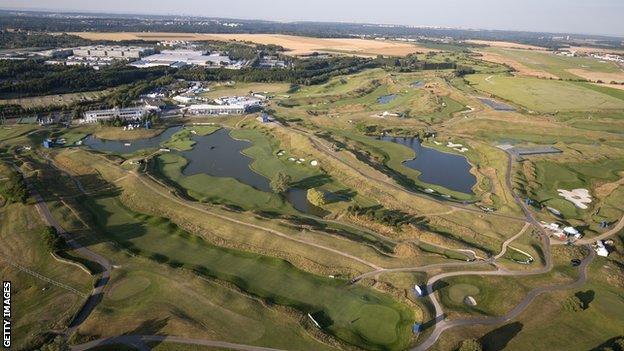
Paris' Le Golf National will host the Ryder Cup from 28-30 September
Players from the European and United States teams will be taking on the Albatros course at Le Golf National when the Ryder Cup begins on Friday.
Situated south-west of Paris, it has regularly hosted the European Tour's French Open since 1991.
Welshman Jamie Donaldson, who hit the match-clinching wedge shot at the 2014 Ryder Cup, will be in Paris for BBC Radio 5 Live.
Here, the former world top-30 player tells BBC Sport why the Versailles venue is "one of the best courses in the world".
Hole 1 - par four, 419 yards
You want it right of centre off the tee because the water comes in on the left if you pull it. There will be a lot of people bailing out to the right, and there will also be people poking it in the water. Both options are easy to do. But once the tee shot is away, the nerves will die down a bit, temporarily.
Stay right of the pin with your second shot. Anything on the left and the green runs away from you diagonally, so you want to be slightly right of the flag.
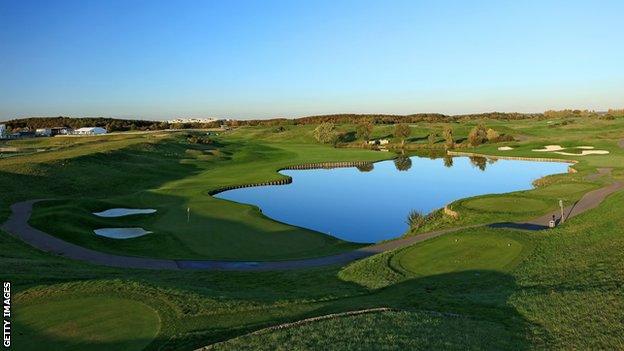
The first green at Le Golf National and the par-three second hole
Hole 2 - par three, 210 yards
The second is a downhill par-three, it's a difficult hole and easy to go long. If you go short you are in the water. You want to be left of the pin, even though the green sits right to left on a diagonal away from the tee shot, but anything left of the flag is bringing the water into play.
Hole 3 - par five, 558 yards
Anything down the right is a) going in the water, and b) blocking out the second shot. If you can hit your tee shot down the left-hand side of the fairway you have a better line and a safer shot into the green.
The green is kidney-shaped, short on the left and deeper on the right - any shot in there with a three iron to five wood wants to be down the left.
There is a bunker lurking on the right and a tree on the left. Anything to the right, finishing middle of the green, would be perfect. But it's hard to get close to a back-right flag.
Hole 4 - par four, 486 yards

The Tiger line is down the left of the 486-yard par-four fourth, but most will go right
There is more room right than you think, so you are best off down the right-hand side of the fairway.
The left is more the Tiger Woods line, but you are bringing in the bunkers. Ideally you want to be slightly right of centre, which opens up the hole. Iron into the middle of the green, you can attack pins on the right but not so much on the left, unless you draw the ball.
Middle of the green is a decent play, especially in foursomes. It's a good, strong hole.
Hole 5 - par four, 405 yards
Five has bunkers all the way down the left and thick rough down the right. You want to be down the left-hand side of the fairway if you can, towards the bunkers, setting up a pitching wedge into the green.
You can be pretty aggressive to most of the flags on that green. The one short and left probably causes a few problems, but the ones to the right are pretty straightforward. It gets very narrow at the back of the green, so to get it close to a back flag is a really good shot.
Hole 6 - par four, 380 yards
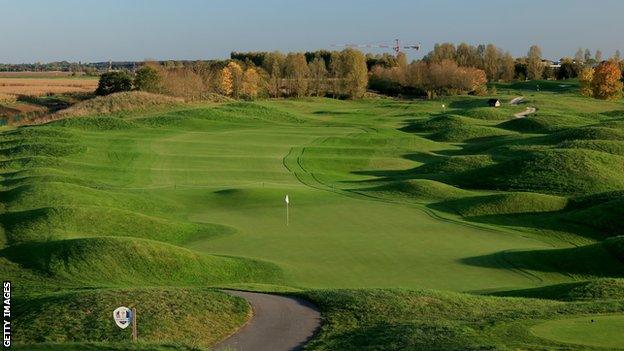
Big hitters can drive the sixth green, expect to see birdies
Six is usually driveable with a three wood. There's thick rough down the left and out of bounds down the right. You want to be anywhere on the fairway, but the best shot is right centre, which opens up the green a bit more. You play down the green, as opposed to across it.
Most of the flags are accessible. You'll see lots of birdies on five and six.
Hole 7 - par four, 457 yards
It's a difficult tee shot. It's paramount you hit the fairway or you're making bogey, because a lay-up is difficult to get anywhere near the green. Anything down the right of the fairway gives a better second shot but it's a tough shot because too far right is pretty much dead. There's thick rough and an elevated fairway, so you want to be left centre.
It's tricky to get close to some of the flags on the green, depending on how far down the fairway you are. You run out at about 320 yards, so it won't benefit any big hitters.
It will be an interesting hole in matchplay.
Hole 8 - par three, 208 yards
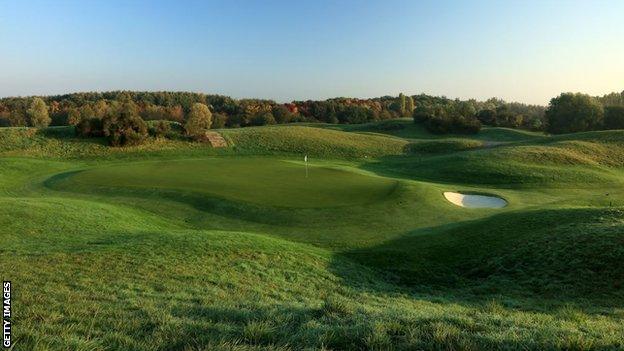
The green on the downhill par-three eighth is tricky to find
Eight is a good par three, straight downhill. It's very difficult to hit the green. Anything in the middle of that green is good because you can't really attack a lot of pins. In matchplay you'll see more balls getting closer, but in foursomes you'll see people missing the green and not getting up and down easily.
Hole 9 - par five, 579 yards
There is water down the left, so any of the big-hitters using driver are bringing that in to play. You might see people trying to take it on, trying to get a long way down the fairway and pulling it in the water.
But anything down the left towards the pond gives you a better angle in for your second shot and you'll see people, especially in matchplay, taking it on in two. It's very difficult to get it on the green in two, because it is very narrow.
You'll see people chipping across the green from one side to the other - quite a few funny numbers on that hole, but we'll also see birdies. It'll be a very interesting matchplay hole.
Hole 10 - par four, 375 yards
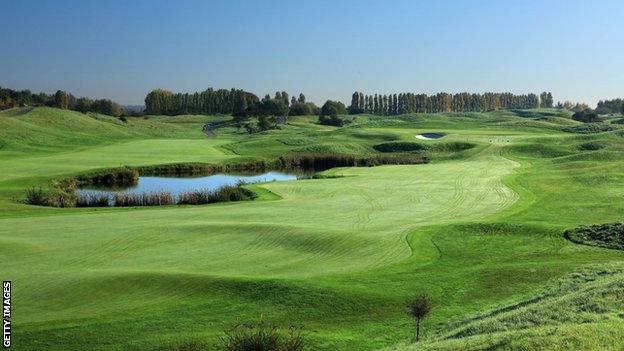
Water lurks to the left of the fairway on the par-four 10th
Ten is tricky. There's water on the left so you want to favour the right. But if you go right you're in the rough and won't be able to get on the green in two. It's a really strong matchplay hole.
Providing people get it on the fairway off the tee, it's not too difficult of an approach shot even though it is slightly elevated. You don't want to go left of any flags with your second shot. You can attack anything down the right side. You'll see birdies there.
Hole 11 - par three, 178 yards
Anything slightly short will run back into the water, so people will go past it the hole if it's near the front of the green. There is a very accessible pin on the right, where all the undulations feed down to the hole. Left pins are quite accessible. Back-right pins are difficult to get it on the right level, so you might see people going long.
Hole 12 - par four, 433 yards
It's a really tight driving hole - trouble down the left, trouble down the right - you have to hit the fairway or else you will struggle to make par.
Left of centre sets up a better line in for your second shot. There are loads of different flags and there will be some interesting scores on this hole. If you hit long down the fairway, you can attack the pin wherever it is. But it's not straightforward.
Hole 13 - par four, 415 yards

There could be birdies at the 13th, providing you find the fairway
A strong tee shot needed. Longer hitters will be able to whip it down the right, but anything slightly left will run out of fairway and will be difficult to hit the green. There's water short, so it's paramount to hit the fairway.
It's probably one of the holes longer hitters will benefit from, because it they bomb it down the right they will leave a chip on to the green.
Providing you hit the fairway, there will be lots of birdies. Every pin is accessible from the fairway but from the rough will be difficult.
Hole 14 - par five, 544 yards
Long hitters will benefit provided they hit the fairway, because they will be getting on the green in two. If you go long and down the right you've got the perfect angle in. Anything left leaves a limited view of the second shot.
People missing the fairway will find lay-ups difficult.
Hole 15 - par four, 408 yards

Expect to see players attacking the pin in matchplay on the 15th
This is where it all gets exciting. It's very important to hit the fairway with the tee shot. Anything left and you won't get on the green with your second, anything right is in the water. It's a very difficult second shot, anything short, left, right, long is in the drink. Matchplay is slightly easier when people can attack pins a bit more, but you'll see balls in the water without question.
It's the start of a very tricky finish.
Hole 16 - par three, 177 yards
You'll see birdies at 16. I don't think many people will hit it in the water - they might do under high pressure, with loose shots at the end of matches, but it shouldn't be too much of a struggle.
Any pushed shots are dead and if you try and play too safe and hit it too far left you've got a really slopey left-to-right to any right flag, which is not easy. It will be a good hole.
Hole 17 - par four, 480 yards
Seventeen is a really good hole. Long hitters will benefit if they can get big drives to land on the fairway.
Anything right is on a bank, anything left in heavy rough. There is more room right than you think, and just right of centre is perfect. If you try and go too straight it's a dogleg slightly right to left, if you go left and pull it a fraction it always ends up in a grassy hollow, from where it is very difficult to hit the green.
Hole 18 - par four, 471 yards
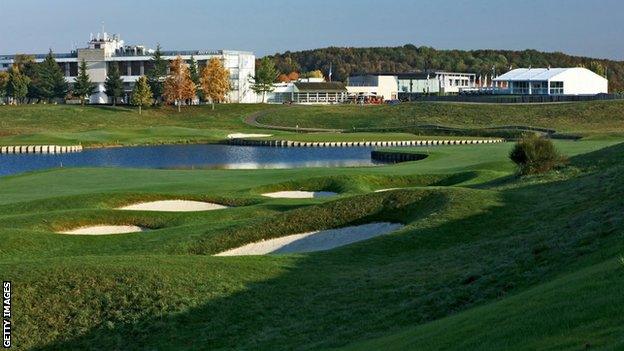
The 471-yard par-four 18th is one of the toughest holes at Le Golf National
Hopefully a lot of matches go to 18. It will be a really strong hole, one of the toughest on the course. A slightly left tee shot is in the water, right is bunkers all the way down. Some of the longer hitters will go miles if they hit the fairway, but if go slightly left or right and there's no shot.
It doesn't matter which side you come in from, it it just paramount to hit the fairway. The left is probably slightly better, but anything on the fairway leaves a good shot in.
A back right flag is difficult, as slightly short or slightly long and you're in the water. Par is a great score and you won't see many birdies.